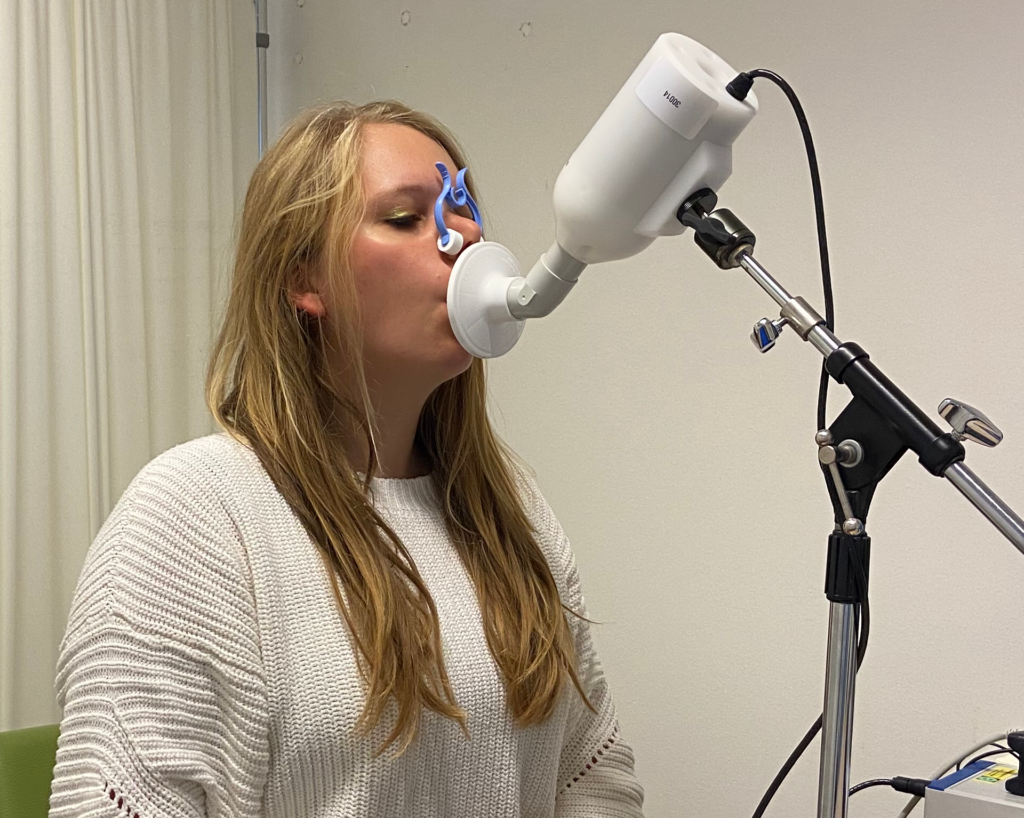
Our core content on Lung conditions and related factsheets has been translated to a number of other languages.
For more languages explore all available Factsheet translations.
Volunteer as a translator or learn how to translate using Chrome, Firefox or Edge browsers.
 European Lung Foundation
European Lung Foundation


Our core content on Lung conditions and related factsheets has been translated to a number of other languages by our volunteer team.
For more languages explore all available Factsheet translations.
Volunteer as a translator or learn how to translate using Chrome, Firefox or Edge browsers.
Home » Electronic nose could spot when a lung transplant is failing

A summary of research presented at the ERS International Congress 2021 [Photo courtesy of Nynke Wijbenga]
A device known as an electronic nose could be used to help spot when a lung transplant is failing, according to new research.
Around 50% of lung transplants can fail within 5 years. It can take several months for doctors to check if a lung transplant is failing; this is known as chronic lung allograft dysfunction (CLAD). Electronic nose technology could play an important role in spotting the signs of transplant failure early on.
The study used a device called an eNose that can detect chemicals in the breath of patients. These chemicals, known as volatile organic compounds (VOCs), can vary depending on what is happening in our body. When a person breathes into the eNose, sensors can detect the pattern of VOCs. A machine then analyses these patterns to identify different lung conditions.
91 people who had received a lung transplant in the Netherlands were involved in the study. The study participants had been living with a lung transplant for an average of three years. eNose measurements were taken between July and November 2020. The eNose measurements were compared with results the consultants had already found from usual tests to spot failing lung transplants.
68 patients included in the study had stable lung transplants and 23 patients had CLAD. In 86% of the cases, the eNose was able to correctly identify people who had a stable lung transplant, compared to people whose lung transplant was failing.
The findings could enable doctors to spot at an early stage when a lung transplant is failing so that they could provide treatments to prevent it from getting worse. However, more research is needed before the eNose could be used in the clinic for this purpose.
This study was presented at the European Respiratory Society (ERS) International Congress in September 2021 but has not yet been published. This means it has not gone through a detailed peer review process used when research is published in a scientific journal.
Title:
Abstract no: OA2914 “Electronic nose for detecting chronic lung allograft dysfunction in lung transplant recipients”, by Nynke Wijbenga et al; Presented in session, “Optimising outcomes of lung transplantation: how to move forward?” at 09:30-11:00 CEST on Tuesday 7 September 2021. Access the abstract online: https://k4.ersnet.org/prod/v2/Front/Program/Session?e=262&session=13678
Sign up to get the latest information and research on lung conditions, hear about our upcoming events and campaigns, plus views from experts and patients! You can unsubscribe at any time.
ELF is a non-profit organisation registered as a UK company (VAT no. GB 115 0027 74) and charity (no. 1118930).
Our Brussels office enterprise number is 0738.383.695
European Lung Foundation's TR ID number in the Transparency Register is: 094039644810-79
| Cookie | Duration | Description |
|---|---|---|
| __Secure-ROLLOUT_TOKEN | 6 months | Description is currently not available. |
| __Secure-YEC | past | Description is currently not available. |
| __Secure-YNID | 6 months | Description is currently not available. |
| Cookie | Duration | Description |
|---|---|---|
| _clck | 1 year | Microsoft Clarity sets this cookie to retain the browser's Clarity User ID and settings exclusive to that website. This guarantees that actions taken during subsequent visits to the same website will be linked to the same user ID. |
| _clsk | 1 day | Microsoft Clarity sets this cookie to store and consolidate a user's pageviews into a single session recording. |
| _ga | 1 year 1 month 4 days | Google Analytics sets this cookie to calculate visitor, session and campaign data and track site usage for the site's analytics report. The cookie stores information anonymously and assigns a randomly generated number to recognise unique visitors. |
| _ga_* | 1 year 1 month 4 days | Google Analytics sets this cookie to store and count page views. |
| CLID | 1 year | Microsoft Clarity set this cookie to store information about how visitors interact with the website. The cookie helps to provide an analysis report. The data collection includes the number of visitors, where they visit the website, and the pages visited. |
| MR | 7 days | This cookie, set by Bing, is used to collect user information for analytics purposes. |
| SM | session | Microsoft Clarity cookie set this cookie for synchronizing the MUID across Microsoft domains. |
| Cookie | Duration | Description |
|---|---|---|
| yt-remote-cast-available | session | The yt-remote-cast-available cookie is used to store the user's preferences regarding whether casting is available on their YouTube video player. |
| yt-remote-cast-installed | session | The yt-remote-cast-installed cookie is used to store the user's video player preferences using embedded YouTube video. |
| yt-remote-connected-devices | never | YouTube sets this cookie to store the user's video preferences using embedded YouTube videos. |
| yt-remote-device-id | never | YouTube sets this cookie to store the user's video preferences using embedded YouTube videos. |
| yt-remote-fast-check-period | session | The yt-remote-fast-check-period cookie is used by YouTube to store the user's video player preferences for embedded YouTube videos. |
| yt-remote-session-app | session | The yt-remote-session-app cookie is used by YouTube to store user preferences and information about the interface of the embedded YouTube video player. |
| yt-remote-session-name | session | The yt-remote-session-name cookie is used by YouTube to store the user's video player preferences using embedded YouTube video. |
| ytidb::LAST_RESULT_ENTRY_KEY | never | The cookie ytidb::LAST_RESULT_ENTRY_KEY is used by YouTube to store the last search result entry that was clicked by the user. This information is used to improve the user experience by providing more relevant search results in the future. |